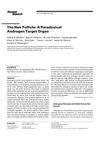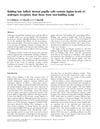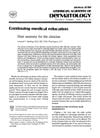TLDR Testosterone affects hair follicles differently across body sites, with beard hair follicles showing more activity of a specific enzyme and presence of androgen receptors compared to scalp hair.
The study investigated the effects of testosterone (T) on human hair follicles by examining its metabolism and the localization of androgen receptors in outer root sheath cells (ORSC) and dermal papilla cells (DPC) from various body sites. It was found that T was primarily metabolized to androstenedione in both beard ORSC and epidermal keratinocytes, with beard DPC showing significantly higher 5α-reductase activity compared to occipital scalp and axillary DPC. Androgen receptors were present in beard and axillary DPC but not in occipital scalp DPC. Testosterone did not stimulate proliferation in ORSC or DPC when cultured alone but did so in ORSC co-cultured with beard or axillary DPC, suggesting that beard and axillary DPC produce androgen-dependent growth factors that stimulate follicular epithelial cells.
124 citations
,
April 1992 in “Journal of Endocrinology/Journal of endocrinology” Beard hair follicles have more androgen receptors than non-balding scalp hair follicles.
106 citations
,
April 1986 in “British Journal of Dermatology” Dermal papilla cells from human hair follicles form unique structures and don't live as long as other skin cells in lab conditions.
 122 citations
,
November 2010 in “Journal of Dermatological Science”
122 citations
,
November 2010 in “Journal of Dermatological Science” Male pattern baldness involves hormones and cell signals affecting hair growth.
 66 citations
,
January 2000 in “Hormone Research in Paediatrics”
66 citations
,
January 2000 in “Hormone Research in Paediatrics” Androgens can both promote and prevent hair growth due to differences in gene expression in hair follicles.
231 citations
,
December 1999 in “Journal of Investigative Dermatology” Hair follicle size is mainly influenced by the number of cells and extracellular matrix volume, with cell number having a larger impact.
 227 citations
,
January 1998 in “Journal of Endocrinology”
227 citations
,
January 1998 in “Journal of Endocrinology” Cells from balding scalps have more androgen receptors than cells from non-balding scalps.
124 citations
,
April 1992 in “Journal of Endocrinology/Journal of endocrinology” Beard hair follicles have more androgen receptors than non-balding scalp hair follicles.
 139 citations
,
July 1991 in “Journal of The American Academy of Dermatology”
139 citations
,
July 1991 in “Journal of The American Academy of Dermatology” Understanding hair follicle anatomy helps diagnose hair disorders.




